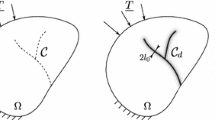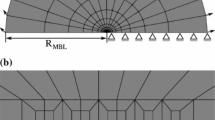Abstract
The influence of material heterogeneities is studied in the context of dynamic failure. We consider a pre-strained plate problem, the homogeneous case of which has been widely studied both experimentally and numerically. This setup is used to isolate the effects of the elastic field resulting from pre-straining and stress wave interactions throughout the crack propagation by adding stiffer and denser regions in the plate. While the crack tip is pushed away by stiffer inclusions, it is attracted to the denser ones. With the presence of denser media, only a portion of the total elastic energy in the system is effectively used to drive crack propagation, leading to a drop in the velocity of its tip in comparison to the homogeneous case. Crack branching is then observed at velocities much lower than the limiting velocity of the material, questioning the validity of crack velocity to be a criterion for crack branching. Instead, we introduce an effective stored energy to analyze the crack velocity and the emergence of crack branching instabilities.














Similar content being viewed by others
Notes
The limiting velocities are in the range of 0.5–0.65 \(c_R\) for glass, 0.58–0.62 \(c_R\) for PMMA, and \(0.3{-}0.45 c_R\) for Homalite-100, see Ravi-Chandar (2004) and references therein.
References
Albertini G, Kammer D (2017) Supershear transition of dynamic mode II fracture in heterogeneous elastic media. J Mech Phys Solids (submitted)
Barenblatt G (1962) The mathematical theory of equilibrium cracks in brittle fracture. Adv Appl Mech 7(1):55–129
Belytschko T, Liu WK, Moran B, Elkhodary K (2014) Nonlinear finite elements for continua and structures, 2nd edn. Wiley, Hoboken
Ben-Zion Y (2008) Collective behavior of earthquakes and faults: Continuum-discrete transitions, progressive evolutionary changes, and different dynamic regimes. Rev Geophys 46(4):RG4006
Bleyer J, Molinari JF (2017) Microbranching instability in phase-field modelling of dynamic brittle fracture. Appl Phys Lett 110(15):151903
Bleyer J, Roux-Langlois C, Molinari JF (2017) Dynamic crack propagation with a variational phase-field model: limiting speed, crack branching and velocity-toughening mechanisms. Int J Fract 204:79–100
Bobaru F, Zhang G (2015) Why do cracks branch? A peridynamic investigation of dynamic brittle fracture. Int J Fract 196(1–2):59–98
Bouchbinder E, Goldman T, Fineberg J (2014) The dynamics of rapid fracture: instabilities, nonlinearities and length scales. Rep Prog Phys 77(4):046501
Camacho G, Ortiz M (1996) Computational modelling of impact damage in brittle materials. Int J Solids Struct 33:2899–2938
Chen W, Ravichandran G (1996) Static and dynamic compressive behavior of aluminum nitride under moderate confinement. J Am Ceram Soc 79(3):579–584
Clark A, Irwin G (1966) Crack-propagation behaviors. Exp Mech 6(6):321–330
Courant R, Friedrichs K, Lewy H (1967) On the partial difference equations of mathematical physics. IBM J Res Dev 11(2):215–234
Cox B, Gao H, Gross D, Rittel D (2005) Modern topics and challenges in dynamic fracture. J Mech Phys Solids 53(3):565–596
Dugdale D (1960) Yielding of steel sheets containing slits. J Mech Phys Solids 8(2):100–104
Fineberg J, Bouchbinder E (2015) Recent developments in dynamic fracture: some perspectives. Int J Fract 196(1–2):33–57
Fineberg J, Gross S, Marder M, Swinney H (1991) Instability in dynamic fracture. Phys Rev Lett 67(4):457
Fineberg J, Gross S, Marder M, Swinney H (1992) Instability in the propagation of fast cracks. Phys Rev B 45(10):5146
Fisher D, Dahmen K, Ramanathan S, Ben-Zion Y (1997) Statistics of earthquakes in simple models of heterogeneous faults. Phys Rev Lett 78(25):4885
Fleck N, Deshpande V, Ashby M (2010) Micro-architectured materials: past, present and future. In: Proceedings of the royal society of London a: mathematical, physical and engineering sciences, vol 466. The Royal Society, pp 2495–2516
Goldman T, Livne A, Fineberg J (2010) Acquisition of inertia by a moving crack. Phys Rev Lett 104(11):114301
Ha Y, Bobaru F (2010) Studies of dynamic crack propagation and crack branching with peridynamics. Int J Fract 162(1–2):229–244
Hillerborg A, Modeer M, Petersson P (1976) Analysis of crack formation and crack growth in concrete by means of fracture mechanics and finite elements. Cem Concr Res 6:773–782
Johnson J, Holloway D (1968) Microstructure of the mist zone on glass fracture surfaces. Philos Mag 17(149):899–910
Livne A, Bouchbinder E, Fineberg J (2008) Breakdown of linear elastic fracture mechanics near the tip of a rapid crack. Phys Rev Lett 101(26):264–301
Livne A, Bouchbinder E, Svetlizky I, Fineberg J (2010) The near-tip fields of fast cracks. Science 327(5971):1359–1363
Livne A, Cohen G, Fineberg J (2005) Universality and hysteretic dynamics in rapid fracture. Phys Rev Lett 94(22):224–301
Marder M (1991) New dynamical equation for cracks. Phys Rev Lett 66(19):2484
Marder M (1998) Adiabatic equation for cracks. Philos Mag B 78(2):203–214
Molinari JF, Gazonas G, Raghupathy R, Rusinek A, Zhou F (2007) The cohesive element approach to dynamic fragmentation: the question of energy convergence. Int J Numer Methods Eng 69(3):484–503
Murali P, Guo T, Zhang Y, Narasimhan R, Li Y, Gao H (2011) Atomic scale fluctuations govern brittle fracture and cavitation behavior in metallic glasses. Phys Rev Lett 107(21):215–501
Ortiz M, Pandolfi A (1999) Finite-deformation irreversible cohesive elements for three-dimensional crack-propagation analysis. Int J Numer Methods Eng 44:1267–1282
Palmer A, Rice J (1973) The growth of slip surfaces in the progressive failure of over-consolidated clay. Proc R Soc Lond A Math Phys Sci 332(1591):527–548
Ramulu M, Kobayashi A (1985) Mechanics of crack curving and branching—a dynamic fracture analysis. Int J Fract 27(3):187–201
Ravi-Chandar K (2004) Dynamic fracture. Elsevier, Amsterdam
Ravi-Chandar K, Knauss W (1984) An experimental investigation into dynamic fracture: III. On steady-state crack propagation and crack branching. Int J Fract 26(2):141–154
Ruiz G, Ortiz M, Pandolfi A (2000) Three-dimensional finite-element simulation of the dynamic Brazilian tests on concrete cylinders. Int J Numer Methods Eng 48(7):963–994
Sagy A, Cohen G, Reches Z, Fineberg J (2006) Dynamic fracture of granular material under quasi-static loading. J Geophys Res Solid Earth 111(B4):B04406
Seelig T, Gross D (1999) On the interaction and branching of fast running cracks—a numerical investigation. J Mech Phys Solids 47(4):935–952
Sharon E, Fineberg J (1999) Confirming the continuum theory of dynamic brittle fracture for fast cracks. Nature 397(6717):333–335
Sharon E, Gross S, Fineberg J (1995) Local crack branching as a mechanism for instability in dynamic fracture. Phys Rev Lett 74(25):5096
Snozzi L, Caballero A, Molinari J (2011) Influence of the meso-structure in dynamic failure simulation of concrete under tensile loading. Cem Concr Res 41:1130–1142
Song JH, Wang H, Belytschko T (2008) A comparative study on finite element methods for dynamic fracture. Comput Mech 42(2):239–250
Wolff C, Richart N, Molinari JF (2015) A non-local continuum damage approach to model dynamic crack branching. Int J Numer Methods Eng 101(12):933–949
Xu XP, Needleman A (1994) Numerical simulations of fast crack growth in brittle solids. J Mech Phys Solids 42(9):1397–1434
Yoffe E (1951) The moving Griffith crack. Lond Edinb Dublin Philos Mag J Sci 42(330):739–750
Zhang Z, Wu F, Gao W, Tan J, Wang Z, Stoica M, Das J, Eckert J, Shen B, Inoue A (2006) Wavy cleavage fracture of bulk metallic glass. Appl Phys Lett 89(25):251917
Zhou F (1996) Study on the macroscopic behavior and the microscopic process of dynamic crack propagation. Ph.D. thesis, The University of Tokyo, Tokyo
Zhou F, Molinari JF, Shioya T (2005) A rate-dependent cohesive model for simulating dynamic crack propagation in brittle materials. Eng Fract Mech 72(9):1383–1410
Author information
Authors and Affiliations
Corresponding author
Rights and permissions
About this article
Cite this article
Yılmaz, O., Bleyer, J. & Molinari, JF. Influence of heterogeneities on crack propagation. Int J Fract 209, 77–90 (2018). https://doi.org/10.1007/s10704-017-0239-6
Received:
Accepted:
Published:
Issue Date:
DOI: https://doi.org/10.1007/s10704-017-0239-6




